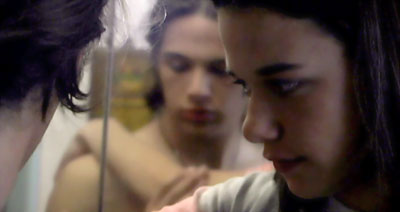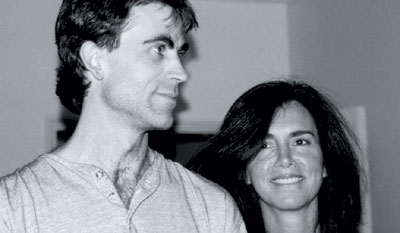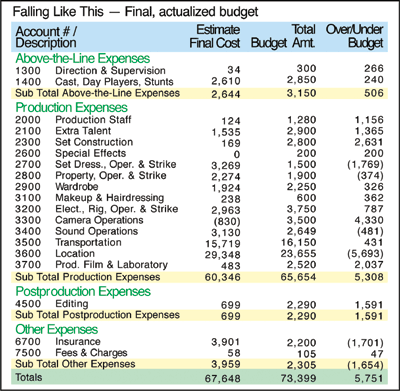DV CASE STUDY: FALLING LIKE THIS
Filled with car chases, period detail, and scores of extras, Dani Minnick’s Falling Like This is a stunning-looking DV feature realized on a slim $68,000 budget. Here, producer Lulu Zezza reveals her production secrets.
 |
| Brian Vaughan and Megan Wilson in Falling Like This. |
Each generation produces its own no-budget cinema style. In the early ’90s, dialogue was cheap. Whether flowing, jabbering or stacatto, dialogue-packed scenes caught by an observant camera characterized the early (and sometimes later) styles of Hal Hartley, Kevin Smith and Quentin Tarantino, to name just a few.
If this previous generation grew up on the films of John Cassavetes and the plays of David Mamet, then the latest bunch of no-budget filmmakers riff on different sources — namely, the DV experiments of Dogme 95 founders Lars von Trier and Thomas Vinterberg. With Vinterberg’s The Celebration as the seminal pic, a new crop of Americans are experimenting with the mobile, gestural camerawork and off-kilter editing rhythms found in that film. A case in point is Dani Minnick’s honest and beautifully realized Falling like This. A stunning DV feature produced for about $68,000, the film premiered at the 2001 Slamdance Film Festival. Thrillingly shot and edited by Alessandro Zezza, the film is an economical teen epic about an aimless girl who gets involved with a sweet, violent and unlucky older boy. Falling Like This’s substantial production values come not just from its Ani di Franco score, car chases and crashes, and name cast — Karen Young and John Diehl join newcomers Brian Vaughan and Megan Wilson — but also from its vivid montage.
Says Minnick, “Alessandro and I are both influenced by cinema vérité. We like a very fluid camera and a style that places the viewer ‘inside’ the picture — allowing them to make their own choices. I would have done this film on 16mm, vérité style, but after seeing The Celebration we raised money and bought a Canon XL-1.”
Filmmaker asked producer Lulu Zezza if she’d reveal Falling like This’s budget and working plan to us. Below, Zezza analyzes the film’s final, actualized budget — the first column consists of the film’s final cost, the second is what Zezza originally budgeted, and the third is the difference. We should note that Zezza is a seasoned producer and line producer, having worked on such films as Portrait of a Lady and Tortilla Soup, and was able to use her connections to cajole a professional crew into working on deferment. Make sure to read through to the piece’s end, where Zezza notes what’s not in that $68K. While some of the film’s substantial post-Slamdance expenses have been covered by exec producer Visionbox Media, the filmmakers are still struggling with others.
PRODUCER LULU ZEZZA ON THE MAKING OF FALLING LIKE THIS:
How it all started — We had no money! It was Thanksgiving, and we — director Dani Minnick, d.p./editor Alessandro Zezza, actor/producer John Diehl and myself — knew that producing Dani’s first feature would be a full-time job from the moment we said, “Let’s do this!” until the end of the shoot. Since we could only afford to be “unemployed” for a few months, we decided to raise as much money as we could by February, and if that amount was enough to make the film on the lowest-possible budget, to “greenlight” production with a mid-March start date. I determined that if we could raise a minimum of $60,000, we could deliver the film on video. We did, and we did.
One fundraising note: No one likes to say “no,” but a “maybe” rarely becomes a “yes.” We sent our fundraising proposal to everyone we knew in early January and required a response within a month. Either they could invest by February 8 or they couldn’t. This pushed people off the “maybe” fence. Some people asked for extensions, but, of those, only two wound up putting in any money. And today, almost two years later, some are still saying “maybe!”
Our budget included virtually no money for labor. The labor money we did spend was paid to the L.A.P.D. for our endless street closures, to teacher/welfare workers, to guardians for our young cast (all the kids including our two leads were under 18 and required on-set schooling, etc.), and to occasional technical experts. There were no allowances to pay stipends to the cast or crew.
In hindsight, we made one big “mistake,” but it was one that allowed us to make the film with such a short “development” period: We signed up with the Screen Actors Guild (SAG) under their Experimental Agreement, which allowed us to employ both union and non-union actors and not pay them any salaries. (We did allow for a few stunt adjustment payments for some of the high-risk driving and fight scenes.) The downside of this approach is that the Experimental Agreement is not intended for films with any intention of seeking significant distribution. This deal requires you to renegotiate with your cast and SAG prior to making a deal with a distributor, so you are at their mercy, especially if the offer you receive is not lucrative enough to cover the cost of “bumping up” all of your actors to SAG scale rates.
 |
| Alessandro Zezza and Dani Minnick |
THE BUDGET:
 |
The core of our budget was for the non-negotiable costs:
Extras: We never paid any extra more than $25, but we had lots of them, and at times lots of child extras, each with adult guardians to match.
Art department: Set dressings, supplies, props were all acquired from junk yards, garage sales and our own homes. We needed to get an old jeep into the living room of our main location — and jeeps are not designed to fit through doors. We had to spend some money to buy an old wreck, saw it into pieces that would fit through the front door, and then piece it back together like a Leggo set.
Costumes: We needed lots of police uniforms. We borrowed a few from a TV pilot, but their generosity could only go so far. The clothes were also all period, so our costumer searched every thrift store, Salvation Army, Goodwill etc., to find old clothes for close to nothing.
Make-up: We only equipped oursevles with the most basic supplies. We got most of what we needed through the make-up school where we found our assistants.
Electric/grip: Our entire grip-electric package fit into a cargo van — a very, very full cargo van with a rack on the roof for overflow. Our largest light was a 2K par. We really wished we had a 5K too for our exteriors, but we just couldn’t afford it. We worked mainly with Kino Flos and 1K pars indoors. We shot entirely handheld except for car mounts, so we did not need money or space for a dolly. Virtually all our expendables were “donated” by bigger shows. We did invest in a 2K tungsten helium balloon which worked very hard and often throughout the shoot. We were able to sell it easily later.
Camera: Dani and Alessandro felt strongly that Falling Like This should be shot very intimately — handheld and ideally multi-camera to allow a young and probably inexperienced cast more freedom of movement and continuity. The two of them had used a substantial amount of handheld work on their previous short film, which they shot on 35mm. To shoot the whole picture multi-camera, handheld on film was going to be prohibitively expensive for the stock, processing and camera gear.
A very important factor in our deciding to go for making Falling was the film The Celebration. When Dani and Alessandro saw that film, they knew that although MiniDV was not as “pretty” as film, it could deliver a picture with equal narrative punch. Alessandro immediately began investigating our options and we decided to buy one Canon XL1 package (which we then sold after we locked picture, resulting in a “profit” in this category), and rented the second Canon package and most of the accessories.
Sound:We did not spend enough money or attention to sound during the shoot! No matter how expensive it seems relative to the $5 you have to make your film, spend money on the set on sound. It will cost a fraction of what “fixing it in post” will cost. I don’t know why, but while you can find an extremely qualified and talented crew in all other areas to work for free, it is very hard to find the same experience for free in the sound department. Pay your soundman!
Picture cars: We needed cars and cars, pick-up truck after pick-up truck, a cop car chasing after another cop car — all of them dated late-’70s to early-’80s. And, to top it off, we needed to throw a truck off a cliff! This was almost our biggest single budget item. (The truck that went off the cliff actually doubled for four other trucks in the film — we became very good friends with the Same-Day-Auto-Paint!)
Transportation: Our entire transportation department was a pick-up truck, a two-room trailer and a cargo van. Wardrobe traveled in the trunk of our costumer’s car. Camera fit in Alessandro’s Honda Prelude. We had one “Teamster” volunteer, who was tireless and protective. Treat your drivers well, and they will do the same and more for you.
Locations: The City of Los Angeles cost more than any other entire department. We paid a whopping total of $625 in location rentals, and then we paid over $19,000 to the various city departments for the privilege of filming on streets and public properties (schools, courthouse, parks) of L.A. We did not take out any permits for when we were filming on private property. This could have made our lives very difficult if anyone had complained about us, but it was simply too expensive. We were as polite as possible to all the neighbors.
Catering & Craftservice: You’ve heard it before but no matter what your budget is, feed everyone as well as you possibly can! We spent almost $10,000 on food, and it was all well spent.
Production “Film and Lab”: What more can I say about MiniDV? We shot 80 hours of footage, which would have translated into more than 500,000 feet on 35mm film.
Even if we had shot on 16mm, we never could have afforded anywhere near the amount of coverage we wound up with. We did not make endless takes of the same setup, in fact our average was six. We did average over 40 setups per day, which was partly due to the fast and easy DV camera reloads, but largely due to shooting handheld with a very fast crew. If we had been working with film, I would have had to pull the plug on scene coverage because of film-stock allowances well before we had any time worries. Yes, we still have the cost of the transfer to film, but that cost is less than the cost of film stock and processing, and it is a cost you don’t have to spend until you have a good reason to deliver the picture on film.
Tests: Note the absence of an allowance. Don’t make the same mistake. If you are considering filming digitally, spend the time and money to test your systems. Postproduction begins with your choice of camera. Camera and sound are extremely inter-dependent and your choice of editing system will affect your sound recording system on set. Test everything before you begin principal photography. We recorded sound directly into the Canon’s input jacks and had serious sound problems with overmodulation. We wound up being rescued by B-Camera’s built-in microphone. Some preproduction testing may have allowed us to debug this problem before it was indelibly recorded in our production sound.
Editing: Alessandro chose a Windows NT platform. He used the SpeedRazor editing system with the DV MasterPro capture card. We started with 40 gigs of memory and finished with 500 gigs (three 100-gig arrays and then several smaller hard-drives). Thank goodness we own the editing system. Owning the system allowed us to edit for a very, very long time — more than a year. It has also allowed us to cut promo reels and trailers, to pull production stills, to do our own color correction and some “film-look” tests. The system now has virtually no re-sale value, but it has been a big value to us. If we had been using a friend’s system or renting one, we would never have had the freedom of time that ownership gave us.
Insurance: We took out a basic production insurance package for one month with enough coverage to allow us to easily rent the equipment and facilities we needed, and to provide the liability coverage required by the City of L.A. and most of the location owners.
WHAT IS NOT IN THE BUDGET (WE OWE FAR MORE THAN WE SPENT):
Postproduction Sound: These costs can be small or huge depending on the quality of your production sound. We estimate $45,000 for additional sound work, including a Music and Effects mix (M&E) for foreign distribution.
Delivery Elements: $50,000 for color-correction and the transfer to film. $30,000 for an Answer Print, Inter-Positive and Inter-Negative. A telecine back to Digibeta for the video delivery will be $7,000. The Continuity Script for subtitling and dubbing costs $2,500.
The Cast: The SAG Experimental Agreement requires a conversion to the Low-Budget Agreement when the film is distributed. Our cast budget at the low-budget rates with SAG fringes is about $112,000.
The Crew: Unpaid wages minimums (calculated at IATSE, the film technical unions) is almost $340,000.
Music Licenses: Ani Di Franco and The Redbone Hounds have been very generous with their music. We will owe them $36,000.
Above-the-Line: And last but not least, our own fees for writing, directing and producing the film.
Marketing: And then, don’t forget the costs of marketing the film to festivals and distributors just to get to the point of making that elusive sale. We have won the Hamptons, Florida, and Temecula Film Festival. We also won the cinematography award at the Hamptons, the Festival Directors award at MethodFest and we were the closing night film at Slamdance. These festivals cost money to support and to attend. The costs do not end with the application fee. There are the postcards, the posters, the giveaways, the video dubs (we’re at well over 300 now and still counting), the special screenings (we have put on at least four). Fortunately our producer’s rep, Visionbox Pictures, is paying these costs, but it will also have to recoup them along with their commission.
Ultimately, there are many, many budgets for every film that is produced. Yes, our film cost $67,648 to “make,” but we will not break-even until we recoup over a million!
Falling Like This will be released this winter by Outrider. Use the links below to the following pdf files to view the complete budget.
VOD CALENDAR


 See the VOD Calendar →
See the VOD Calendar →


